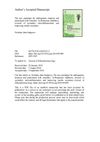TLDR The argon gas-based cryotherapy effectively reduced keloid scars but caused some hypopigmentation and had a recurrence rate, especially in Afro-American patients.
This study evaluated the effectiveness of an argon gas-based intralesional cryotherapy system for treating keloid scars in 25 patients with 30 keloid scars, including all Fitzpatrick skin types, over a 1-year follow-up. The treatment resulted in a significant 62% reduction in scar volume, improved scar quality, and alleviated pain and itching. However, 17% of scars recurred, particularly in Afro-American patients, and hypopigmentation was a notable issue. The argon gas-based system proved effective, especially for scars previously unresponsive to liquid nitrogen-based cryotherapy.
91 citations
,
November 1987 in “Archives of Dermatology” 303 citations
,
August 1971 in “The American Journal of Medicine” Melanocytes are destroyed by factors needed for melanin production, causing vitiligo and gray hair.
31 citations
,
August 1963 in “Archives of Dermatology” No systemic causes were found for the patients' conditions.
April 2024 in “International journal of molecular sciences” Combination pharmacotherapy is generally more effective for treating keloids and hypertrophic scars.
 34 citations
,
July 1987 in “The Journal of dermatologic surgery and oncology”
34 citations
,
July 1987 in “The Journal of dermatologic surgery and oncology” Improved dermabrasion techniques in 1987 led to better treatment results for skin issues like acne scars.
 16 citations
,
September 2018 in “Journal of Ethnopharmacology”
16 citations
,
September 2018 in “Journal of Ethnopharmacology” Plant-based remedies may treat hair loss by reducing inflammation and improving insulin resistance.
24 citations
,
August 2021 in “Scientific Reports” Non-thermal plasma could help hair growth by activating key cell signals.
6 citations
,
February 2024 in “Pharmaceutics” ELIP-based CRISPR delivery improves heart disease gene editing but needs more testing.

